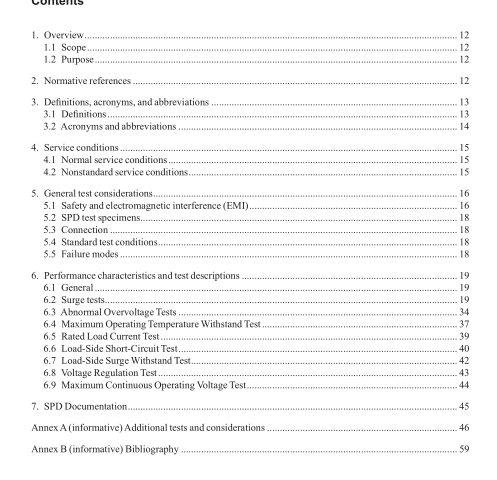IEEE C62.62-2010 pdf download.IEEE Standard Test Specifcations for Surge-Protective Devices (SPDs) for Use on the Load Side of the Service Equipment in Low-Voltage (1000 V and Less) AC Power Circuits
Appropriate precautions shall be taken to keep these factors within manageable limits. Precautions may include suitable extinguishing agents in suffcient quantity, physical separation from other combustibles, or other appropriate measures.
In evaluating the possibility of explosion, consideration should be given to component failure whenever hazardous materials are available in suffcient quantity to create an explosive atmosphere. The voltage and current levels generally associated with surge testing are well above those considered lethal, with short-duration voltages typically up to 20 000 V and impulse currents typically up to 10 000 A or higher. Steady-state voltages can typically be up to 600 V rms with a fault current potential of thousands of amperes. Considerations to the risk of accidental discharge of the surge generator, the consequences of a fashover to an unfavorable circuit, the possibility of a charge being trapped in the SPD, or the consequence of a violent component failure should be considered.
Test personnel should never stand in the line of sight of components on printed circuit boards or panels with the enclosure open during SPD surge testing. On occasion, a component can unexpectedly fail in an explosive manner during surge testing.
Fragments of the ruptured case and the component might cause injury to personnel in the vicinity. If visual observation is required, a suitable transparent barrier shall be provided. Surge testing of SPDs is best conducted only in an area dedicated solely to that purpose. The boundaries of the area should be clearly defned and appropriately marked.
The surge test area should be kept free of all materials, meters, and test setups that are not associated with the surge test being conducted (see the example in A.14). Where possible, the area should be isolated and equipped with appropriate guarding or safety controls (interlocks, etc.) at all entrances into the test area. All metal fences and barriers should be bonded to the laboratory grounding system. Consideration should be given to the possibility of the surge fashing over to circuits or metallic objects that were not intended to be surged. When the SPD can be enclosed in an effective barrier, the preceding requirements for installation are easier to satisfy.
This barrier may simply be suffcient separation—including separation from the foor, which should be presumed to contain conduit or other metal. Alternatively, the entire barrier may be made up of physical insulation. In either case, it should be complete, except where it is penetrated for insertion of input or output lines and measurements probes; and it must be able to provide adequate protection for a peak voltage equal to at least twice the peak of the incident test surge. (Circuits in breakdown at or near the surge peak can oscillate at high frequencies.
Such oscillatory fashovers can thereby increase effective applied peaks by a factor approaching two.) Interlocks should be provided to minimize risks associated with access between tests. The surge generator and SPDs can contain capacitors that store electrical energy.
Suitable discharge circuits or short-circuiting devices should be provided to protect the operator against any such trapped charge after completion of the test surge. EMI from surge testing could conceivably cause malfunction of robots and other automatic equipment, and such equipment should be isolated from the immediate vicinity of surge testing operations.
The importance of conducting surge tests in a prudent manner cannot be overemphasized; safeguarding personnel has to be the prime consideration. For additional guidance regarding safety during testing and working on or near energized circuits, see OSHA 29 CFR 1910 [B13] and NFPA 70E-2015 [B12].IEEE C62.62 pdf download.IEEE C62.62-2010 pdf download
IEEE C62.62-2010 pdf download

Leave a Reply